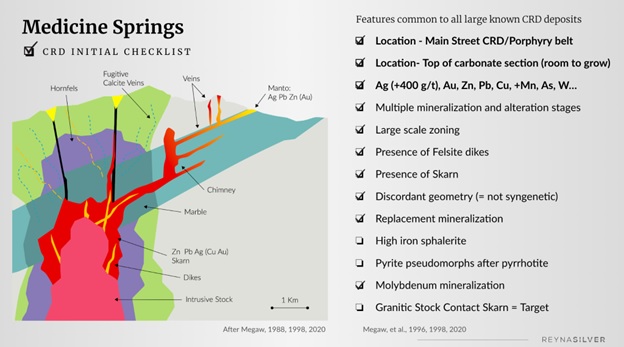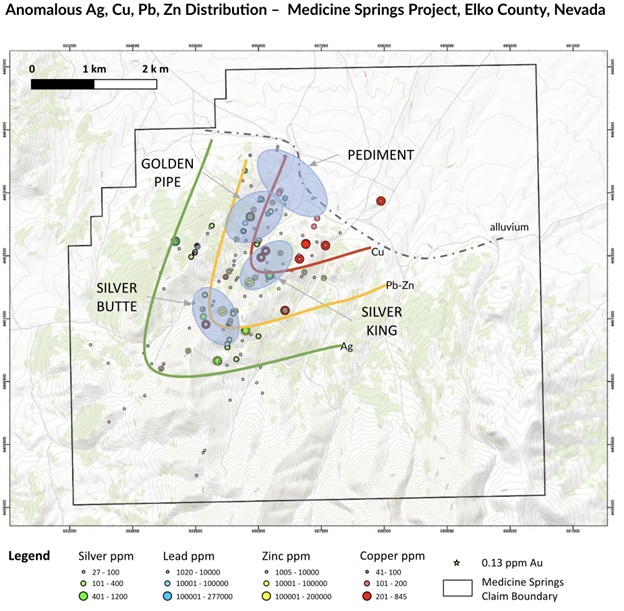Reyna Silver Announces Drill Mobilization to Medicine Springs
Reyna Silver Corp. has received drilling permits and is mobilizing for its initial 4,000m Phase 1 drilling program at the Medicine Springs Project in Nevada. The property covers 4,831 hectares and poses the potential for high-grade mineralization. Initial drilling will explore key parameters of the Carbonate Replacement Deposit (CRD) system, which shows strong indicators of being a significant discovery. The company is excited to evaluate previously unrecognized features of the CRD that may lead to valuable mineralization.
- Drilling permits obtained for 4,000m Phase 1 program.
- Strong indicators of high-grade mineralization at Medicine Springs.
- Potential for district-scale Carbonate Replacement Deposit system.
- None.
Insights
Analyzing...
VANCOUVER, BC and HONG KONG, CHINA / ACCESSWIRE / September 8, 2022 / Reyna Silver Corp. (TSXV:RSLV)(OTCQX:RSNVF)(FRA:4ZC) ("Reyna'' or the "Company") is pleased to report it has received drilling permits and has begun mobilizing for its fully budgeted initial 4,000m Phase 1 drilling program on the 4,831 hectares Medicine Springs Project in Elko Co., Nevada. Reyna can Earn-In an
Medicine Springs lies just southeast of Elko, NV on the eastern side of the Ruby Mt. Range. Geological features identified at Medicine Springs indicate the presence of a Carbonate Replacement Deposit (CRD) exposed at a very distal level, suggesting that the entire CRD-Porphyry continuum should be intact. Regionally, Medicine Springs lies in a belt of highly productive Porphyry Copper systems, so it is possible that the intrusive driver of mineralization at Medicine Springs may also be an economically important target.
Drilling targets for the Phase 1 drilling campaign at Medicine Springs are defined by reinterpretation of controls on historically mined high-grade mineralization combined with new detailed structural, geochemical, and geophysical field studies of the area. Holes are designed to define key parameters of the Carbonate Replacement Deposit (CRD) mineralization including: thickness of the favorable host rock package; continuity of the well-defined mineralized structures to depth; and key features of mineralization that support Reyna's proprietary exploration model for the project.
"Medicine Springs has revealed strong indicators of being a high-grade, district-scale CRD play and we are really excited about being the first group to evaluate it on that basis", said Jorge Ramiro Monroy, the CEO of Reyna Silver. "Now that we have our permits in hand we are mobilizing quickly to drill our first targets, which are designed to define the project's overall framework and see how much mineralization we can find."
"What we see at Medicine Springs includes 10 of the 13 major features we expect to see at the very top of a large CRD system… and we see these before drilling our first hole!" said Dr. Peter Megaw, Chief Exploration Advisor to Reyna Silver. "The project has the right address, we've already identified high-grade silver mineralization, and we can see evidence of a long-lived, multi-phase system at work. In short, all the ingredients that tell us to "Drill here" are present and we look forward to what the rig delivers."
About CRDs
Carbonate Replacement Deposits (CRDs) are high-grade, sulfide-rich, polymetallic (Ag-Pb-Zn-Cu-Au) systems that form through repeated reactions between magma-driven hydrothermal fluids and carbonate-dominant wall rocks. Their high multi-element grades, potentially large size and generally straightforward underground mining and beneficiation-plus their typically limited environmental footprint- makes CRDs attractive exploration targets.
Major recent advances in CRD understanding show a continuous spectrum of mineralization and alteration styles extends from their intrusive centers (in many cases productive Porphyry Copper deposits) to distal-most alteration. This means CRDs are zoned at district to local scales and deciphering a system's zoning provides vectors that lead towards their richest zones. Improved CRD understanding has led to the recognition of key features common to large systems (Figure 1), which not only give early clues to a particular district's potential but also provide a framework for exploration. Most importantly, several major discoveries have been made by applying these advances.

Figure 1. The Carbonate Replacement Model Schematic and associated CRD deposit "Checklist" (Megaw et al, 2020). Medicine Springs checks 10 of 13 key features, most importantly the first three. It is proposed that the entire Porphyry-CRD continuum resides in Medicine Springs from the intrusive stock (noted in hot pink in the diagram) all the way to the most distal part of the system expressed by jasperoids.
WHY MEDICINE Springs
Medicine Springs has been known for over a century through extensive prospecting and small-scale mining plus mid-1980s efforts to drill off a near-surface oxide silver resource at Golden Pipe. Because no exploration was done based on an integrated CRD-district model, the abundant features of a potentially intact CRD system exposed at a very high level went unrecognized until very recently. Medicine Springs already shows many of the key features of large-scale CRDs (Fig. 1), especially the three most important factors: location, location, and grade.
1. Medicine Springs lies within a well-known mineralized belt that includes the nearby Ely and Eureka Mining Districts famous for both their CRD and Cu-porphyry orebodies.
2. Medicine Springs is hosted very high in the regional carbonate stratigraphy meaning a considerable thickness of favorable host rocks underlies the district.
3. Medicine Springs shows high (>400 g/t) silver grades in jasperoid and mineralized outcrops (See Press Release of January 10, 2022) as well as in historic shallow reverse circulation drillholes in the oxide zone.
Medicine Springs also exhibits abundant evidence for other key features of the checklist including multiple mineralization and alteration stages, which are strong indicators of a long-lived, multi-phase CRD system.
Mineralization and alteration at Medicine Springs is tightly controlled by a series of sub-parallel Northeast to Southwest trending faults and fractures that show evidence for repeated movements before and during mineralization. Reyna has focused considerable effort on understanding this plumbing system through detailed geologic mapping and systematic geochemical sampling of jasperoids (metal-bearing silica alteration) developed along the NE-SW structures throughout the district (See Press Release from January 10, 2022). The analytical results from that study revealed a coherent metals zonation that, combined with historic results, provides a number of high-potential initial drill targets.
Targets
Drilling targets for the Phase 1 drilling campaign reflect a combination of the structural, geochemical, geophysical, and historical studies of the area. Initial holes will serve to answer several questions about the system's framework including: thickness and character of the favorable stratigraphy; nature of the structural controls at depth; depth at which sulfide mineralization appears; and amount and style of mineralization. Most of the holes are oriented to cut multiple structures thereby making the best use of drill meters. The priority pads are laid out to test structures of interest associated with the Golden Pipe Mine area, Silver King and Silver Buttes historic prospects, and areas under the pediment along strike to the northeast of the Golden Pipe mine (Figure 2). Note that the Silver King and Silver Butte zones have never been drilled and there is only one historic hole into the pediment zone. All of the historic Golden Pipe drilling is shallow (<125m).

Figure 2. Map of Medicine Springs project with drill targets Silver Butte, Silver King, Golden Pipe and Pediment highlighted in blue ellipses underlain by Ag, Pb, Zn and Cu anomaly results from the 2022 Jasperoid Selective sampling survey.
QUALIFIED PERSON
Dr. Peter Megaw, Ph.D., C.P.G., the Company's Chief Exploration Advisor and Qualified Person, reviewed the technical aspects of the exploration projects described herein and is responsible for the design and conduct of the exploration program and the verification and quality assurance of analytical results. Dr. Megaw is not independent as he and/or companies with which he is affiliated hold Net Smelter Royalties on the Guigui and Batopilas Projects that predate Reyna Silver acquiring them.
ABOUT REYNA SILVER
Reyna Silver Corp. (TSXV: RSLV) is a growth-oriented junior exploration and development company focused on exploring for high-grade, district-scale silver deposits in Mexico and USA.
Reyna's principal properties are the Guigui and Batopilas Properties in Chihuahua, Mexico. Guigui covers the interpreted source area for the Santa Eulalia Carbonate Replacement District (CRD) and Batopilas covers most of Mexico's historically highest-grade silver system. The Company also has an option to acquire
On Behalf of the Board of Directors of Reyna Silver Corp.
Jorge Ramiro Monroy
Chief Executive Officer
For Further Information, Please Contact:
Jorge Ramiro Monroy, Chief Executive Officer
info@reynasilver.com
www.reynasilver.com
Cautionary Statements
This document contains "forward-looking statements" within the meaning of applicable Canadian securities regulations. All statements other than statements of historical fact herein, including, without limitation, statements regarding exploration results and plans, and our other future plans and objectives, are forward-looking statements that involve various risks and uncertainties. Such forward-looking statements include, without limitation, our estimates of exploration investment, the scope of our exploration programs, and our expectations of ongoing administrative costs. There can be no assurance that such statements will prove to be accurate, and future events and actual results could differ materially from those anticipated in such statements. Important factors that could cause actual results to differ materially from our expectations are disclosed in the Company's documents filed from time to time via SEDAR with the Canadian regulatory agencies to whose policies we are bound. Forward-looking statements are based on the estimates and opinions of management on the date the statements are made, and we do not undertake any obligation to update forward-looking statements should conditions or our estimates or opinions change, except as required by law. Forward-looking statements are subject to risks, uncertainties and other factors, including risks associated with mineral exploration, price volatility in the mineral commodities we seek, and operational and political risks. Readers are cautioned not to place undue reliance on forward-looking statements.
SOURCE: Reyna Silver Corp.
View source version on accesswire.com:
https://www.accesswire.com/715159/Reyna-Silver-Announces-Drill-Mobilization-to-Medicine-Springs







